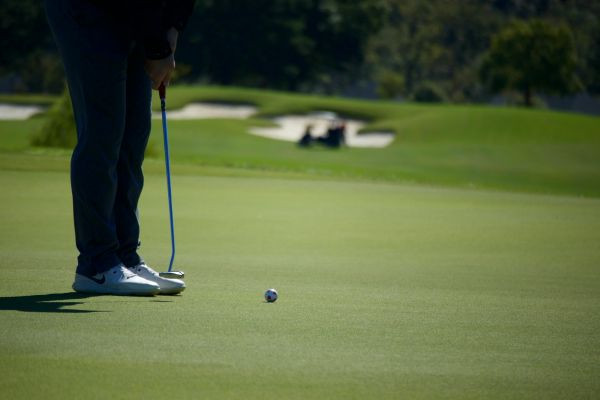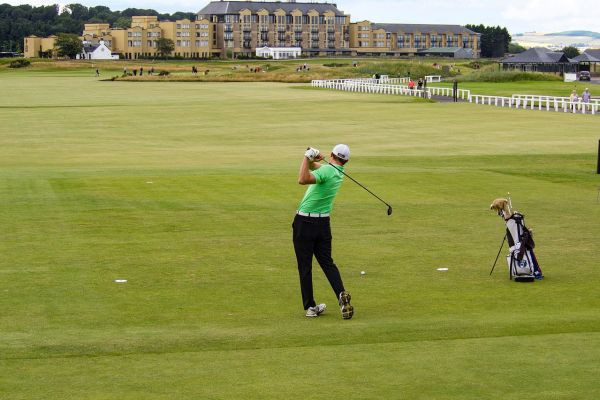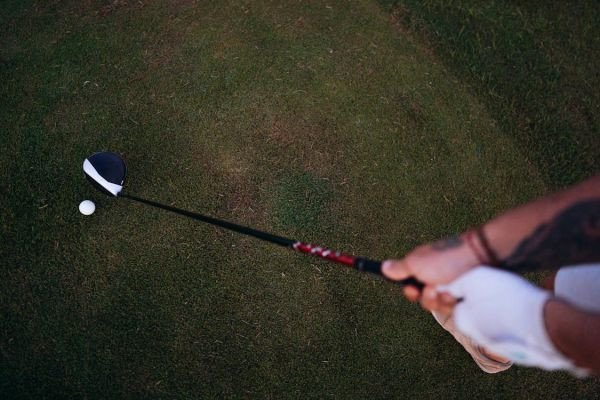Understanding the Key Differences Between Driver Swings and Iron Swings
Golf is not just a sport; it's an art form where every subtle movement can dramatically alter the game's outcome. The swing is the heart and soul of golf and understanding the intricacies of driver an..

Golf is not just a sport; it's an art form where every subtle movement can dramatically alter the game's outcome. The swing is the heart and soul of golf and understanding the intricacies of driver and iron swings is essential. This article will dissect these differences guiding you to a clearer understanding and hopefully a better scorecard.
The Importance of Distinguishing Between Swings
Mastering golf means understanding the purpose and technique behind each type of swing. The driver and iron swings are not interchangeable; each serves a distinct purpose and requires a different approach for optimal performance.
The Driver Swing: The driver is designed for power and distance. It's the club you typically use to start off most holes with the goal of covering as much of the fairway as possible. A successful driver swing relies on a combination of factors such as stance swing path and the angle of attack to propel the ball long distances. The swing is generally wider and more sweeping designed to hit the ball in an upward trajectory reducing backspin and increasing distance.
The Iron Swing: Irons on the other hand are used for a variety of shots from navigating the fairway to approaching the green. They require precision and control. The iron swing is generally more upright and steeper than the driver swing, focusing on hitting the ball with a downward strike to achieve greater accuracy and control. It's about making clean contact with the ball and controlling the flight and landing.
Understanding these fundamental differences is crucial for any golfer looking to improve. Each swing has its mechanics, strategies and subtleties. For instance while a powerful wide-arcing driver swing might cover great distances employing the same technique with an iron could lead to less accurate shots. Conversely the controlled precise swing typically used with an iron might not provide the power needed to effectively use a driver.
Anatomy of a Driver Swing
The driver swing is an integral part of the game of golf designed to maximize both power and distance. Unlike other clubs in your bag the driver is unique because it's not just about how hard you hit the ball but how you hit it. It's a blend of art and science requiring a mix of physical strength and technical finesse.
Position and Posture
The foundation of a powerful driver swing begins with the correct position and posture. Standing with your feet shoulder-width apart offers a balance between stability and flexibility. This stance isn't just a starting position; it's a dynamic part of your swing that influences everything from the club's path to the ball's trajectory. The ball should be positioned just inside your leading foot (closer to the front of your stance). This position is critical because it sets the stage for the clubhead to connect with the ball at the right point in your swing promoting a powerful sweeping motion that maximizes distance and accuracy.
Swing Path and Angle
Understanding the swing path and angle is crucial for mastering the driver. Ideally your driver swing should have a slight upward angle of attack. This means that as the club comes into contact with the ball it's moving upward helping to launch the ball into the air with less spin.
A lower spin rate off the tee can lead to more distance and a straighter flight path. Imagine your swing path as a wide smooth arc. This arc is the path your club takes as it moves through the air. A wider path allows for more power generation much like the winding up of a spring. The key is to maintain a consistent controlled motion that follows this path ensuring that each swing is as effective as the last.
Common Mistakes
Even experienced golfers can fall prey to common mistakes. One such error is over-swinging. In an attempt to hit the ball as far as possible many players swing too hard. This often leads to a loss of control and balance resulting in less powerful and inaccurate shots. It's a counterintuitive concept; sometimes swinging softer can actually make the ball go further.
Another frequent mistake is improper ball positioning. If the ball is too far forward or back in your stance it can lead to slices or hooks. The key to avoiding these issues is practice and patience. Understanding the mechanics of your swing is the first step to correcting these mistakes.
Dissecting the Iron Swing
Iron swings are the precision tools in your golfing arsenal. They're designed for accuracy and control allowing you to navigate the various challenges a course presents with precision.
Position and Posture Variations
The position and posture for an iron swing differ significantly from those of a driver. Typically the ball is positioned more towards the middle of your stance. This central positioning is crucial for a downward strike which is essential for achieving crisp contact and a controlled flight. It's about hitting the ball first then the turf creating that quintessential divot that signifies a well-executed iron shot. The posture is more bent over than with a driver promoting a steeper swing path that's necessary for this type of contact.
Swing Dynamics
The dynamics of an iron swing emphasize precision over power. The swing is generally more upright or vertical than with a driver. This vertical motion allows for a more significant downward strike essential for creating the backspin that helps control distance and provides stopping power on the green. It's a less sweeping motion and more of a targeted strike requiring a great deal of control and practice to master.
Typical Challenges
Several common challenges can arise with iron swings. Hitting the ground before the ball known as a "fat shot" or catching the ball too high known as a "thin shot" are frequent issues. These problems often stem from improper swing mechanics such as incorrect weight distribution or timing. The key to overcoming these challenges is understanding the cause and practicing the correct technique until it becomes second nature.
Mastering both the driver and iron swings is a journey that requires understanding practice and patience. Each has its intricacies and challenges but with dedication and the right guidance you can improve your game significantly. It's not just about hitting the ball; it's about crafting the perfect swing for the shot at hand. Whether you're teeing off with your driver or approaching the green with your iron the right technique will make all the difference.
The Two Main Differences
Understanding the key distinctions between driver and iron swings is essential for any golfer looking to improve their game. While there are many subtleties and nuances in every swing two primary differences stand out significantly and consistently: ball position and swing plane. These elements are fundamental to the mechanics and success of each swing type.
Ball Position and Its Impact
The position of the ball within your stance is one of the most critical aspects of your swing. For a driver the ball is positioned further forward closer to your leading foot. This positioning is designed to align with the lowest point of your swing arc allowing for an upward strike as the clubface meets the ball. This upward motion is crucial for achieving the desired launch angle and minimizing spin which together maximize distance.
Conversely when using an iron the ball is positioned more centrally in your stance. This position encourages a downward strike where the clubface contacts the ball first followed by the turf. This striking motion is key to achieving the backspin needed for ball control and precision. The difference in ball position might seem minor but it significantly alters the swing's entire dynamics affecting the angle of attack, the trajectory of the ball and ultimately the success of the shot.
The Subtle Shift: Weight and Angle
Another fundamental difference lies in how you distribute your weight and the angle of your body during the swing. With a driver the weight shifts more towards the back foot during the swing setup. This shift is subtle but critical. It sets up the body to promote an upward strike necessary for the driver's desired ball flight. The body's angle slightly tilted away from the target further aids this motion.
For iron swings the weight shifts forward promoting the downward strike needed for these clubs. The shift is more pronounced compared to the driver with a noticeable lean towards the target. This forward weight distribution ensures the club descends on the ball creating the crucial downward strike that leads to effective iron shots. These shifts in weight and body angle might seem minor but they are pivotal in executing the correct swing for each type of club.
Practical Tips for Both Swings

Understanding the differences is just the start. Here are some practical actionable tips to help you enhance your performance with both drivers and irons.
Driver Swing Tips
Smooth Rhythm Over Power: While it's tempting to equate speed with distance a smooth and rhythmic swing is often more effective. Focus on a controlled fluid motion to maintain balance and accuracy.
Relaxed Grip: Maintaining a firm grip is important when holding the golf club. You want your grip to be firm enough for control. Stay relaxed to allow for a smooth and fluid swing. Avoid over gripping as it can negatively impact your swing speed and result in less powerful shots.
Wide Arc: When using a driver aim for creating a swing arc. This doesn't mean extending your arms but rather focusing on achieving a natural backswing and follow through. A wider arc can increase the speed at which the clubhead connects with the ball resulting in more powerful shots.
Iron Swing Tips
Ball Then Turf: For iron shots it's crucial to make contact with the ball before hitting the turf. This downward strike ensures control and creates backspin.
Hands Ahead at Impact: At the moment of impact ensure that your hands are slightly ahead of the ball. This position promotes improved contact with the clubface and helps maintain a controlled flight path.
Visualize the Trajectory: Before each swing take a moment to visualize how you want the shot to travel. Visualizing your intended trajectory helps align your body and swing with your target enhancing accuracy.
Transitioning Between Swings
Transitioning smoothly between using your driver and irons is a skill that can greatly enhance your game.
Being able to effectively switch between the driver and the more controlled iron is crucial. This section provides strategies to make these transitions as smooth as possible.
Mental and Physical Adjustments
Mental Preparation: The first step towards a transition is preparing yourself mentally. Recognize that the swings for drivers and irons are fundamentally different requiring a change in technique. Before switching clubs take a moment to clear your mind and focus on the adjustments you need to make. Visualize the swing you're about to perform and the desired outcome. This mental shift is just as important as the physical one.
Physical Adaptation: The physical aspect of transitioning involves adjusting your stance, grip and swing to match the club you're going to use. Practice modifying your ball position from being forward in your stance for drivers to a centered position for irons. Feel how weight shifts for each type of swing – on the back foot for drivers and more towards the front, for irons. The more you practice these adjustments the more natural they will feel during your game.
Practice Routines
To enhance your practice transition, between different swings incorporating specific exercises can be highly beneficial. Here are a couple of strategies to consider:
Alternating Practice: During your practice sessions alternate between hitting a series of drives and iron shots. This not only helps your body adapt physically but also trains your mind to switch gears quickly and effectively.
Game Simulation: Create practice scenarios that mimic real game situations. For instance start with a driver off the tee. Then move on to an iron shot just like you would on an actual hole. This approach not only aids in transitioning but also enhances your overall game strategy.
Advanced Techniques and Troubleshooting
Experienced golfers continuously work on refining their swings. Understanding advanced techniques and troubleshooting issues can lead to significant improvements in your game.
Fine-Tuning Your Swing
Professional Lessons: Sometimes seeking a different perspective can provide insights that you might miss on your own. Consider taking lessons from a golf instructor who can offer personalized advice and coaching tailored to your needs. They will be able to identify areas for improvement and provide drills and strategies to address them.
Video Analysis: Utilizing video technology can offer a wealth of information about your swing mechanics allowing you to analyze it effectively. Looking at your swing from various angles can be helpful in identifying any problems with your stance, swing path or follow through that might not be noticeable during the swing. Many modern facilities provide this technology. You can ask a friend to record your swing for review.
Common Issues and How to Solve Them
Slicing and Hooking: These are issues that often occur due to a grip or swing path. Make sure your grip is neither too tight nor too loose and ensure that your swing path is not far inside or outside. Practice drills that encourage a straighter swing path and a grip that results in a clubface at impact.
Hitting Fat or Thin Shots: It can be quite frustrating when you consistently hit the ground before the ball ( shots) or barely make contact with the ball ( shots). These problems often stem from an incorrect stance and improper weight distribution. Focus on drills that promote a balanced stance and a smooth swing that makes contact with the ball. Pay attention to how your weight shifts, during the swing – it should be fluid and consistent.
Technology and Training Aids
Technology and training aids have become tools for golfers of all skill levels in today's era. These advancements provide insights and improvements to your practice that were once exclusive to professionals. By understanding and utilizing these tools you can make an impact on enhancing your game.
Gadgets and Gear
Launch Monitors: Among the revolutionary technological devices available to golfers today are launch monitors. These tools offer detailed feedback on every aspect of your swing as well as the ball's trajectory. They measure variables such as swing speed, launch angle, spin rate and carry distance providing an analysis of your performance. This data is invaluable in understanding your strengths while also identifying areas that require improvement.
Golf Simulators: Another remarkable technological advancement is golf simulators. These simulators allow you to practice and play in an environment, which proves useful when outdoor conditions are unfavorable. Simulators can recreate courses while offering feedback on your game. They also serve as a means to keep your skills sharp during the off season.
Recommended Training Aids
Alignment Sticks: Amateurs and professionals alike utilize these effective tools for improving their game. Alignment sticks play a role in ensuring that your body, hips and feet are positioned correctly when you address the ball. This helps promote an accurate swing.
Impact Bags: Impact bags which are specifically designed to assist in perfecting the moment of impact. By striking the bag you can develop muscle memory for the club position, at impact. This is particularly beneficial for iron swings, where precision's of importance.
Swing Trainers: Swing trainers come in various forms. Focus on different aspects of your swing. Some trainers help with tempo and rhythm while others aid in improving swing path and plane. Finding the right swing trainer can effectively address any faults and reinforce positive habits.
Conclusion
Understanding and mastering the differences between driver swings and iron swings is truly a journey. It involves learning, adjusting and most importantly practicing. The subtleties between each type of swing may seem small. Have an impact on enhancing your game.
Golf is a sport that encourages learning and adaptation. Every round. Every swing taken presents an opportunity to gain insights. Embrace the intricacies and nuances of this game.
Enjoy the process of improving and don't hesitate to try out techniques, training tools or technologies. Your journey towards becoming a golfer is unique. Every step you take forward is an accomplishment worth celebrating. Remember it's not about being perfect but making progress.
Frequently Asked Question (FAQs)
1. What is the primary difference between a driver swing and an iron swing?
The primary distinctions lie in the position of the ball and the path of your swing. When using drivers, place the ball forward in your stance to create an angle of attack for distance. On the other hand the irons position the ball centrally to encourage a downward strike for better precision and control. The driver swing tends to be wider and more sweeping while the iron swing is steeper and more focused.
2. How can I adjust my stance for a driver versus an iron?
For drivers, stand with your feet shoulder width apart and position the ball near your leading foot to achieve a strike. With irons slightly narrow your stance. Place the ball centrally for accurate downward strikes. These adjustments will help optimize power and accuracy for each type of club.
3. Why is ball position so crucial in golf swings?
The position of the ball has an impact on the angle of impact and swing path which ultimately affects how the shot flies and how far it goes. For drivers placing the ball more towards the front helps launch it higher with more spin. On the other hand for irons a central ball position allows for better control and backspin. Getting the ball positioning right is crucial to achieve your desired outcome with each swing.
4. How often should I practice each type of swing?
To improve your game it's essential to balance your practice between working on both driver and iron swings. Dedicate time to areas that you find challenging and make sure to have frequent practice sessions for both types of swings.
5. Can technology really help improve my golf swing?
The use of technology like swing analyzers can be beneficial as they provide insights into your swing mechanics. These tools offer information such as swing speed and path enabling you to make adjustments and track your progress over time.
6. What are some common driver swing mistakes and how can I avoid them?
There are some mistakes that golfers tend to make including over swinging and incorrect ball positioning. To avoid swinging focus on maintaining a controlled and rhythmic motion rather than relying solely on power. Additionally ensure that you place the ball correctly inside your leading foot and practice regularly to maintain an effective driver swing.








































































